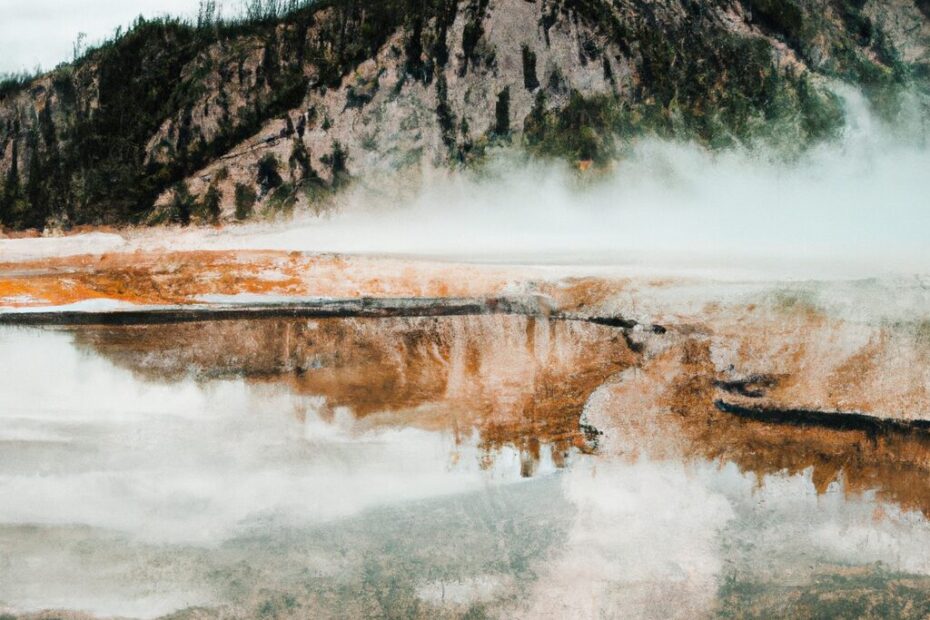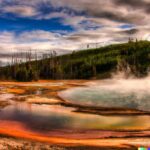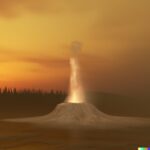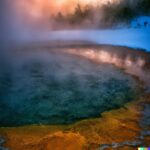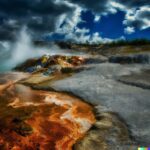Have you ever wondered about the mysterious and powerful natural phenomena known as geysers? In this article, we will explore the formation of geysers, the different types that exist, and the fascinating factors that contribute to their eruptions. Specifically, we will delve into the frequency and predictability of eruptions in Yellowstone National Park, home to some of the most iconic geysers in the world. Join us as we unravel the science behind these awe-inspiring displays of nature’s power.
What Are Geysers?
Geysers, particularly notable in Yellowstone National Park, are iconic thermal features that showcase geothermal activity through their unique eruption patterns.
These natural wonders are formed when underground water is heated by magma beneath the Earth’s surface, causing pressure to build up and eventually result in a spectacular release of steam and water.
Yellowstone National Park is home to over 500 geysers, including the famous Old Faithful, which erupts at regular intervals, providing visitors with a mesmerizing display of nature’s power.
The eruption pattern of geysers can vary from minutes to days, with some geysers having predictable schedules while others are more unpredictable, adding an element of excitement and mystery to exploring the park’s geothermal wonders.
How Are Geysers Formed?
The formation of geysers is intricately linked to the interplay of geothermal and volcanic activity, shaping these remarkable natural features.
Geysers, like the famous Old Faithful in Yellowstone National Park, are born from the heat deep within the Earth’s crust. As underground water seeps through porous rocks, it comes into contact with these hot zones, causing it to heat up and expand. Eventually, the pressure builds up until the water bursts out in a spectacular display of steam and boiling water. This cycle of heating, pressurizing, and release is what sustains the continuous eruptions that make geysers such fascinating geological wonders.
What Are the Different Types of Geysers?
Various types of geysers exist, each with distinct characteristics and behaviors, particularly evident in the diverse geothermal landscape of Yellowstone.
- Examples of geysers in Yellowstone showcase a range of eruption patterns, from the predictable intervals of Old Faithful to the irregular activity of Steamboat Geyser.
- Geysers can also be classified based on their size, with some towering high into the sky while others are more modest in stature.
- The chemical composition of geysers’ water can vary widely, influencing the colors and formations seen around their vents.
- Studying these variations provides valuable insights into the geological processes at work beneath the surface.
What Causes Eruptions in Geysers?
Understanding the causes of eruptions in geysers involves analyzing factors such as regional volcanic activity, the presence of magma chambers, and seismic data.
These geothermal features are intricately connected to the geological history of the Yellowstone region. The volcanic activity in this area has played a significant role in shaping the behavior of geysers. Magma movements underneath the surface can create the pressure necessary to cause eruptions, while the seismic activity can act as a trigger for releasing built-up energy. By studying these interactions, scientists gain insights into the dynamic processes that lead to the mesmerizing displays of water and steam in geysers.
What Is the Role of Pressure in Geyser Eruptions?
Pressure plays a pivotal role in geyser eruptions, influencing the dynamics of the underlying geothermal system and aiding in eruption forecasting efforts.
When the pressure within a geyser’s underground chambers reaches a critical point, it triggers the release of hot water and steam, leading to the spectacular eruption that we witness above ground. By monitoring these pressure variations, scientists can better understand the patterns of geyser activity and potentially predict when an eruption might occur. This understanding is crucial for the safety of nearby habitats and the preservation of these natural wonders, ensuring the sustainable management of geyser systems amidst the volatile forces of nature.
How Does Water Temperature Affect Geyser Eruptions?
Water temperature serves as a critical factor in influencing geyser eruptions, reflecting the geothermal conditions and contributing to the assessment of eruption risks.
Monitoring the water temperature of geysers provides valuable insights into the underlying geothermal activity. Slight changes in temperature can indicate shifts in pressure and heat below the surface, offering vital clues to geologists and park officials.
By analyzing these temperature variations, scientists can better predict potential eruptions and manage the associated risks. Understanding the relationship between water temperature and geyser behavior is crucial for safeguarding both the environment and visitors to these natural thermal wonders.
What Role Does the Geyser’s Plumbing System Play in Eruptions?
The geyser’s plumbing system plays a crucial role in regulating eruptions, governing the flow of geothermal resources and providing valuable data for eruption studies.
These complex underground networks of channels and reservoirs not only manage the release of pressurized water and steam during eruptions but also significantly impact the overall behavior and frequency of geyser activities. By controlling the pathways through which geothermal fluids ascend to the surface, the plumbing system influences the temperature, pressure, and composition of the eruptive materials. This intricate system not only offers insights into the underlying geothermal processes but also serves as a critical resource for scientists studying geothermal energy production and sustainability.
What Is the Frequency of Eruptions in Yellowstone?
The frequency of eruptions in Yellowstone is a subject of interest, analyzed through geophysical monitoring and observations of geological events in the region.
Geophysical monitoring techniques such as seismometers and GPS instruments play a crucial role in detecting changes in the Earth’s crust beneath Yellowstone. By measuring seismic activity and ground deformation, scientists can track the movement of magma underground. Observations of geological events like steam explosions, changes in hydrothermal features, and gas emissions provide valuable insights into the potential buildup of volcanic pressure. These combined methodologies offer a comprehensive understanding of the volcanic processes occurring within the park.
How Often Do the Major Geysers Erupt?
Quantifying the eruption frequency of major geysers involves the expertise of geologists and the analysis of seismic data to track and predict their activity.
Geologists play a crucial role in understanding the eruption patterns of geysers in Yellowstone National Park. Through the monitoring of seismic data, these experts evaluate the seismicity beneath the surface to forecast potential eruptions. By analyzing the frequency, duration, and intensity of geyser eruptions, geologists can establish patterns that help predict when the next eruption may occur. This data-driven approach enables scientists to better comprehend the underlying geological processes driving geyser activity, contributing to a deeper understanding of volcanic systems and their behavior.
Are Eruptions in Yellowstone Predictable?
The predictability of eruptions in Yellowstone is a topic of investigation, drawing insights from the park’s eruption history and assessing volcanic hazards to improve forecasting accuracy.
By examining the historical context of past eruptions in Yellowstone National Park, researchers have been able to gain valuable knowledge about the recurrence intervals and patterns of volcanic activity in the region. Factors such as geological monitoring, seismic activity, gas emissions, and ground deformation play crucial roles in assessing the current state of volcanic unrest. Understanding these volcanic hazards enables scientists to implement early warning systems and develop forecasting models that can potentially enhance the accuracy of predicting future eruptions.
What Factors Affect the Frequency of Eruptions in Yellowstone?
Numerous factors influence the frequency of eruptions in Yellowstone, prompting scientific studies to delve into the complexities of geothermal activity and its impact on eruption patterns.
Researchers are particularly interested in the relationship between seismic activity and volcanic eruptions, as increased seismic activity often precedes eruptions. The monitoring of gas emissions, such as sulfur dioxide and carbon dioxide, is also crucial in predicting volcanic activity. Geological studies have revealed that the movement of magma beneath the surface plays a significant role in determining eruption frequency. By examining these various aspects of geothermal phenomena, scientists aim to better understand the dynamics of Yellowstone’s volcanic system and improve eruption forecasting models.
What Are the Predictability Patterns of Eruptions in Yellowstone?
Understanding the predictability patterns of eruptions in Yellowstone requires insights from geophysical studies and an examination of volcanic phenomena in the region.
Geophysical studies play a crucial role in monitoring the various indicators that precede volcanic eruptions, such as ground deformation, seismic activity, and gas emissions. By studying these signals, scientists can better forecast potential volcanic events and issue timely warnings to mitigate risks.
Notable volcanic phenomena like hydrothermal explosions and geysers also provide valuable information about Yellowstone’s volcanic activity, offering additional clues for predicting eruptions. These geophysical studies are essential for enhancing our understanding of the complex volcanic processes that govern Yellowstone National Park’s volcanic system.
Are Eruptions in Yellowstone Cyclical?
The cyclical nature of eruptions in Yellowstone reflects recurrent eruption patterns tied to the geological formations within the park.
These patterns are a result of the underlying volcanic system that lies beneath Yellowstone. Over time, the pressure builds up within the magma chamber, ultimately leading to eruptions. The presence of the Yellowstone Caldera, a massive volcanic crater formed by past eruptions, plays a pivotal role in shaping these cyclical events. As pressure continues to accumulate, the eruption cycle repeats itself, showcasing a natural rhythm of activity in this geologically dynamic region.
What Are the Most Predictable Geysers in Yellowstone?
Certain geysers in Yellowstone exhibit remarkable predictability, drawing attention from geologists who leverage geologic studies to forecast their eruptions.
By studying these geysers’ behavior patterns over time, geologists can identify subtle changes in temperature, pressure, and water levels that serve as reliable indicators of an impending eruption. This data is crucial in creating models that help geologists predict the timing and magnitude of geyser eruptions with increasing accuracy.
Such insights not only enhance scientific understanding of geothermal activity in Yellowstone but also contribute to public safety measures by allowing for timely warnings and precautions to be put in place to mitigate potential risks from these natural phenomena.
How Do Scientists Predict Eruptions in Yellowstone?
Scientists employ various methodologies to predict eruptions in Yellowstone, leveraging insights from the geothermal field and tracking eruption trends for forecasting accuracy.
Geothermal field data plays a crucial role in understanding the underlying volcanic processes within Yellowstone. By monitoring changes in temperature, pressure, and chemical composition of the geothermal features, scientists can identify potential indicators of volcanic activity. This data is analyzed in conjunction with historical eruption patterns to detect any deviations or anomalies that could signify an impending eruption. Advanced predictive models are utilized to simulate different eruption scenarios and assess the likelihood and intensity of future volcanic events, further enhancing the accuracy of eruption predictions.
Last Updated on February 7, 2024 by Jon Waraas – Originally Posted: February 7, 2024

I’m Jon Waraas, and I’ve been navigating the online world since 2006. By day, I’m the proud owner of some eCommerce gems, and by night, I’m the voice behind the adventures on Waraas.Com.
My heart, however, belongs to the wild beauty of Yellowstone National Park. I’ve got a collection of websites dedicated to sharing the wonders of this natural masterpiece. Oh, and did I mention? I’m currently building my own cabin inside the ghost town of Gilmore, Idaho – a cabin with tales to tell!
When I’m not immersed in the digital realm, you’ll find me lacing up my boots for a good hike or setting up camp under the star-studded sky.
